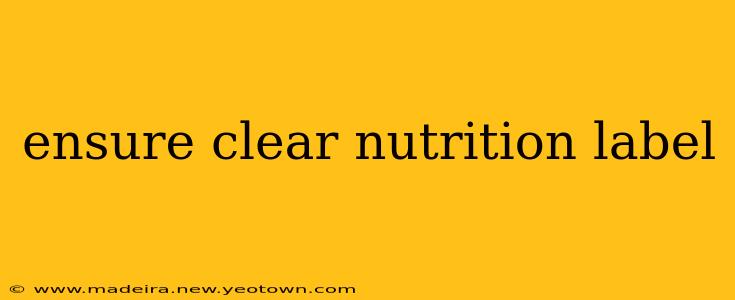Decoding the Nutrition Label: A Story of Clarity and Informed Choices
Let's be honest, staring at a nutrition label can feel like deciphering an ancient scroll. Numbers, percentages, and unfamiliar terms swirl together, leaving many of us feeling confused and overwhelmed. But understanding nutrition labels is the key to making informed choices about the food we consume, contributing to a healthier and happier life. This isn't just about calories; it's about empowering ourselves to become conscious consumers.
My journey to understanding nutrition labels began with a simple question: "What exactly am I eating?" This quest led me down a path of discovery, revealing the hidden secrets within those seemingly cryptic boxes. It's a story I want to share with you, so you too can navigate the world of food labels with confidence.
What information is required on a nutrition label?
This is a fundamental question, and understanding the required components is the first step to mastering nutrition labels. Legally, food labels must display certain key information. This typically includes:
- Serving Size: This is crucial. All the other values are calculated based on this serving size. Pay close attention to this, as a "serving" might be smaller than you anticipate.
- Calories: The total energy content of a serving. We all know calories are important, but understanding how they relate to your daily needs is key.
- Macronutrients: This section lists the grams of fat (total, saturated, and trans), cholesterol, sodium, total carbohydrates (with breakdown into dietary fiber and sugars), and protein.
- Micronutrients: This part showcases the percentage of the Daily Value (%DV) for essential vitamins and minerals like Vitamin D, Calcium, Iron, and Potassium. The %DV is based on a 2,000-calorie diet, so keep your individual needs in mind.
What does the % Daily Value (%DV) actually mean?
This is where things get interesting. The %DV isn't a hard and fast rule; it's a guideline. A 5% DV or less is considered low, while 20% DV or more is considered high. It helps you quickly compare the nutritional contribution of different foods relative to your daily intake goals.
How can I use a nutrition label to make healthy food choices?
The beauty of a nutrition label lies in its ability to empower you to make informed choices. By comparing similar products, you can choose the ones with:
- Lower calories: If weight management is a goal, paying attention to calories per serving is essential.
- Lower saturated and trans fats: These are linked to heart disease, so keeping them low is a wise choice.
- Lower sodium: Excessive sodium can contribute to high blood pressure.
- Higher fiber: Fiber aids in digestion and can help you feel full, which can support weight management.
- Higher vitamins and minerals: Ensure you are getting sufficient amounts of essential nutrients.
Are there any hidden tricks on nutrition labels I should be aware of?
Yes, there are some things to watch out for. Companies sometimes use clever wording or formatting to make their products seem healthier than they are. Look out for:
- Serving size manipulation: Smaller serving sizes can make the values per serving appear lower.
- Focus on positive aspects: They may highlight a small benefit while overlooking larger negative aspects.
- Misleading terms: Be wary of terms like "low-fat" or "light," as they don't always mean what you think they do. Always check the full nutritional information.
Ultimately, understanding nutrition labels is a journey, not a destination. It takes practice and awareness. But by mastering this skill, you are taking control of your health, one label at a time. So, the next time you're grocery shopping, take a closer look—the information is there, waiting to empower you to make the best choices for your well-being.

